Comprehensive Knowledge Audit and Business Analysis of Eni Company
VerifiedAdded on 2020/05/16
|21
|4559
|74
Project
AI Summary
This project presents a comprehensive knowledge audit and business analysis of Eni Company, an integrated energy firm. The report identifies the company's knowledge capabilities, analyzes its business context, processes, and strategic objectives, and highlights the challenges in achieving sustainability. It emphasizes the importance of external and internal environment analysis and proposes an 'Integrated Thinking Approach' to address identified problems. The project utilizes tools like Mind Mapping and process modeling to visualize the business processes and includes a SWOT analysis and strategic plan. The report also addresses ethical and professional issues and provides recommendations based on Key Performance Indicators (KPIs) to measure the company's growth and success. The stakeholders, roles, and responsibilities are clearly defined, along with functional and non-functional requirements. Finally, the project explores organizational frameworks, change and risk management strategies, and offers recommendations for improving Eni's business processes.
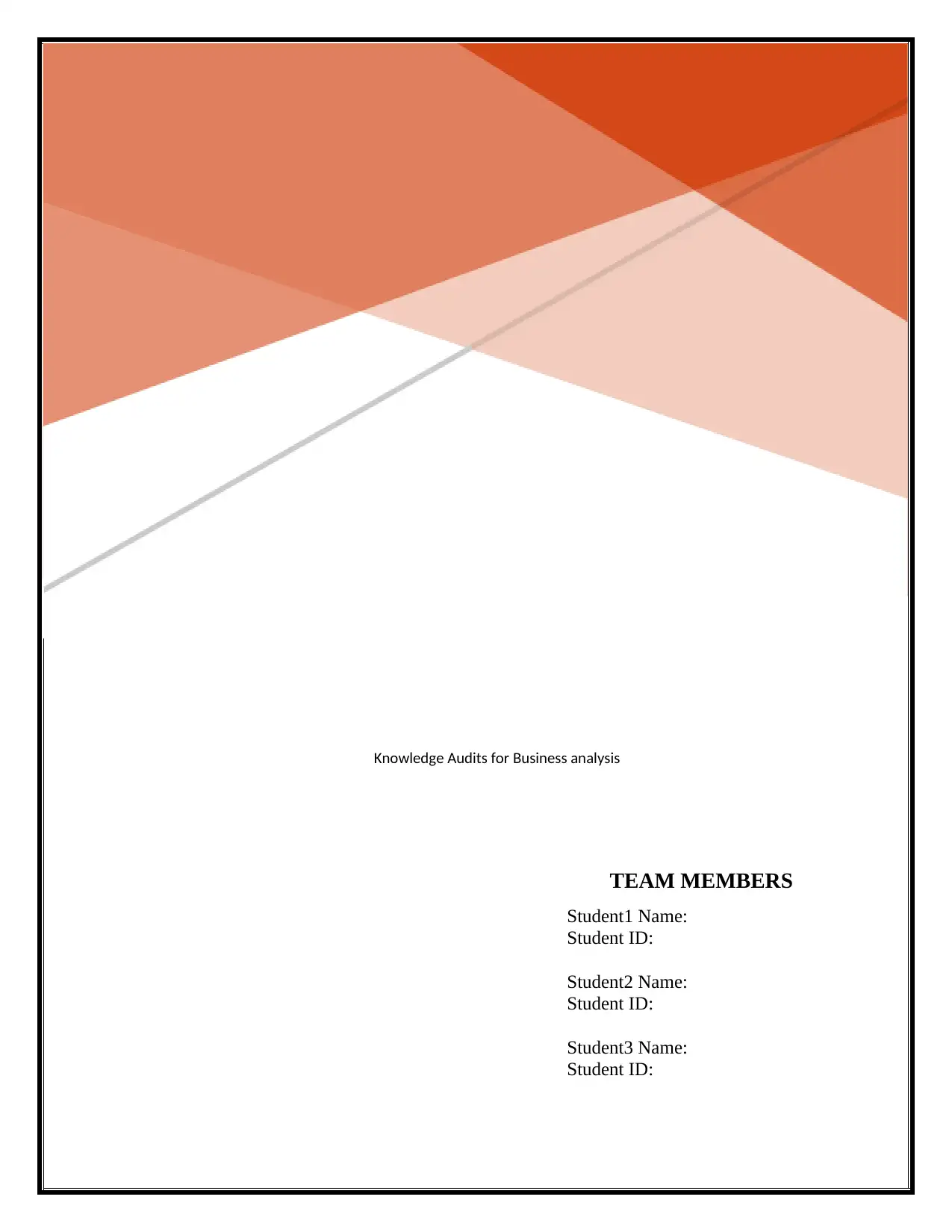
Knowledge Audits for Business analysis
TEAM MEMBERS
Student1 Name:
Student ID:
Student2 Name:
Student ID:
Student3 Name:
Student ID:
TEAM MEMBERS
Student1 Name:
Student ID:
Student2 Name:
Student ID:
Student3 Name:
Student ID:
Paraphrase This Document
Need a fresh take? Get an instant paraphrase of this document with our AI Paraphraser
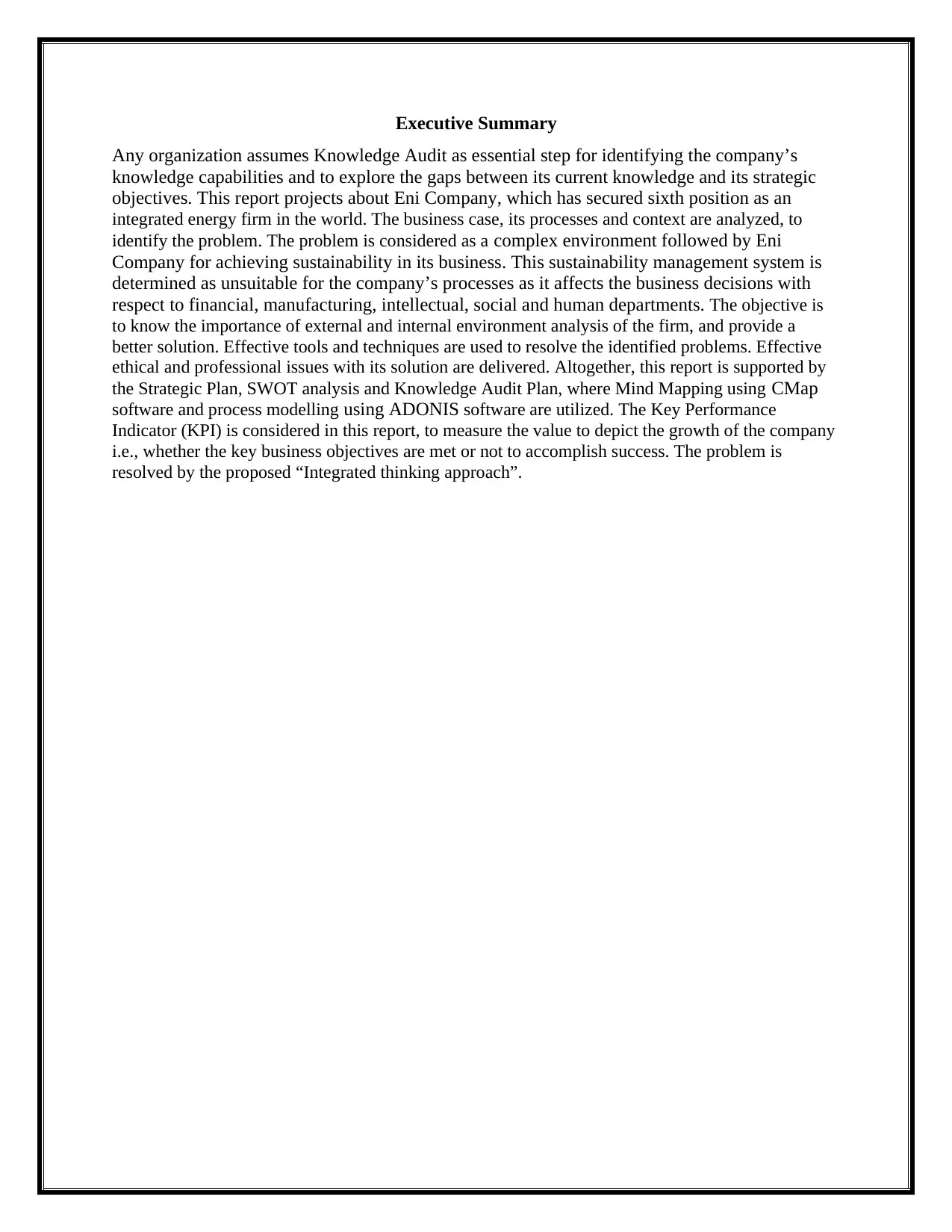
Executive Summary
Any organization assumes Knowledge Audit as essential step for identifying the company’s
knowledge capabilities and to explore the gaps between its current knowledge and its strategic
objectives. This report projects about Eni Company, which has secured sixth position as an
integrated energy firm in the world. The business case, its processes and context are analyzed, to
identify the problem. The problem is considered as a complex environment followed by Eni
Company for achieving sustainability in its business. This sustainability management system is
determined as unsuitable for the company’s processes as it affects the business decisions with
respect to financial, manufacturing, intellectual, social and human departments. The objective is
to know the importance of external and internal environment analysis of the firm, and provide a
better solution. Effective tools and techniques are used to resolve the identified problems. Effective
ethical and professional issues with its solution are delivered. Altogether, this report is supported by
the Strategic Plan, SWOT analysis and Knowledge Audit Plan, where Mind Mapping using CMap
software and process modelling using ADONIS software are utilized. The Key Performance
Indicator (KPI) is considered in this report, to measure the value to depict the growth of the company
i.e., whether the key business objectives are met or not to accomplish success. The problem is
resolved by the proposed “Integrated thinking approach”.
Any organization assumes Knowledge Audit as essential step for identifying the company’s
knowledge capabilities and to explore the gaps between its current knowledge and its strategic
objectives. This report projects about Eni Company, which has secured sixth position as an
integrated energy firm in the world. The business case, its processes and context are analyzed, to
identify the problem. The problem is considered as a complex environment followed by Eni
Company for achieving sustainability in its business. This sustainability management system is
determined as unsuitable for the company’s processes as it affects the business decisions with
respect to financial, manufacturing, intellectual, social and human departments. The objective is
to know the importance of external and internal environment analysis of the firm, and provide a
better solution. Effective tools and techniques are used to resolve the identified problems. Effective
ethical and professional issues with its solution are delivered. Altogether, this report is supported by
the Strategic Plan, SWOT analysis and Knowledge Audit Plan, where Mind Mapping using CMap
software and process modelling using ADONIS software are utilized. The Key Performance
Indicator (KPI) is considered in this report, to measure the value to depict the growth of the company
i.e., whether the key business objectives are met or not to accomplish success. The problem is
resolved by the proposed “Integrated thinking approach”.
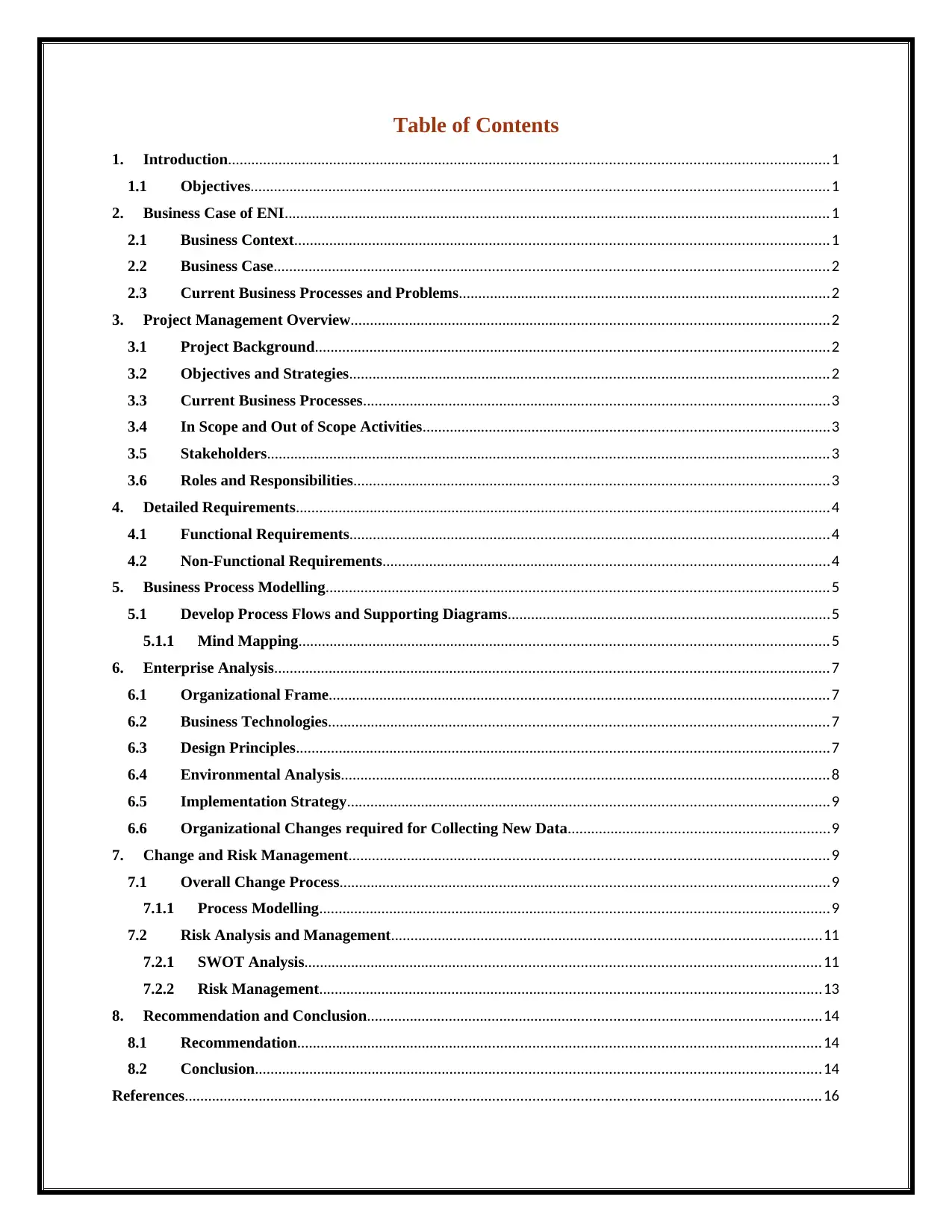
Table of Contents
1. Introduction........................................................................................................................................................1
1.1 Objectives..................................................................................................................................................1
2. Business Case of ENI.........................................................................................................................................1
2.1 Business Context.......................................................................................................................................1
2.2 Business Case............................................................................................................................................2
2.3 Current Business Processes and Problems.............................................................................................2
3. Project Management Overview.........................................................................................................................2
3.1 Project Background..................................................................................................................................2
3.2 Objectives and Strategies.........................................................................................................................2
3.3 Current Business Processes......................................................................................................................3
3.4 In Scope and Out of Scope Activities.......................................................................................................3
3.5 Stakeholders..............................................................................................................................................3
3.6 Roles and Responsibilities........................................................................................................................3
4. Detailed Requirements.......................................................................................................................................4
4.1 Functional Requirements.........................................................................................................................4
4.2 Non-Functional Requirements.................................................................................................................4
5. Business Process Modelling...............................................................................................................................5
5.1 Develop Process Flows and Supporting Diagrams.................................................................................5
5.1.1 Mind Mapping......................................................................................................................................5
6. Enterprise Analysis............................................................................................................................................7
6.1 Organizational Frame..............................................................................................................................7
6.2 Business Technologies..............................................................................................................................7
6.3 Design Principles.......................................................................................................................................7
6.4 Environmental Analysis...........................................................................................................................8
6.5 Implementation Strategy..........................................................................................................................9
6.6 Organizational Changes required for Collecting New Data..................................................................9
7. Change and Risk Management.........................................................................................................................9
7.1 Overall Change Process............................................................................................................................9
7.1.1 Process Modelling.................................................................................................................................9
7.2 Risk Analysis and Management.............................................................................................................11
7.2.1 SWOT Analysis..................................................................................................................................11
7.2.2 Risk Management...............................................................................................................................13
8. Recommendation and Conclusion...................................................................................................................14
8.1 Recommendation....................................................................................................................................14
8.2 Conclusion...............................................................................................................................................14
References.................................................................................................................................................................16
1. Introduction........................................................................................................................................................1
1.1 Objectives..................................................................................................................................................1
2. Business Case of ENI.........................................................................................................................................1
2.1 Business Context.......................................................................................................................................1
2.2 Business Case............................................................................................................................................2
2.3 Current Business Processes and Problems.............................................................................................2
3. Project Management Overview.........................................................................................................................2
3.1 Project Background..................................................................................................................................2
3.2 Objectives and Strategies.........................................................................................................................2
3.3 Current Business Processes......................................................................................................................3
3.4 In Scope and Out of Scope Activities.......................................................................................................3
3.5 Stakeholders..............................................................................................................................................3
3.6 Roles and Responsibilities........................................................................................................................3
4. Detailed Requirements.......................................................................................................................................4
4.1 Functional Requirements.........................................................................................................................4
4.2 Non-Functional Requirements.................................................................................................................4
5. Business Process Modelling...............................................................................................................................5
5.1 Develop Process Flows and Supporting Diagrams.................................................................................5
5.1.1 Mind Mapping......................................................................................................................................5
6. Enterprise Analysis............................................................................................................................................7
6.1 Organizational Frame..............................................................................................................................7
6.2 Business Technologies..............................................................................................................................7
6.3 Design Principles.......................................................................................................................................7
6.4 Environmental Analysis...........................................................................................................................8
6.5 Implementation Strategy..........................................................................................................................9
6.6 Organizational Changes required for Collecting New Data..................................................................9
7. Change and Risk Management.........................................................................................................................9
7.1 Overall Change Process............................................................................................................................9
7.1.1 Process Modelling.................................................................................................................................9
7.2 Risk Analysis and Management.............................................................................................................11
7.2.1 SWOT Analysis..................................................................................................................................11
7.2.2 Risk Management...............................................................................................................................13
8. Recommendation and Conclusion...................................................................................................................14
8.1 Recommendation....................................................................................................................................14
8.2 Conclusion...............................................................................................................................................14
References.................................................................................................................................................................16
⊘ This is a preview!⊘
Do you want full access?
Subscribe today to unlock all pages.

Trusted by 1+ million students worldwide

Paraphrase This Document
Need a fresh take? Get an instant paraphrase of this document with our AI Paraphraser
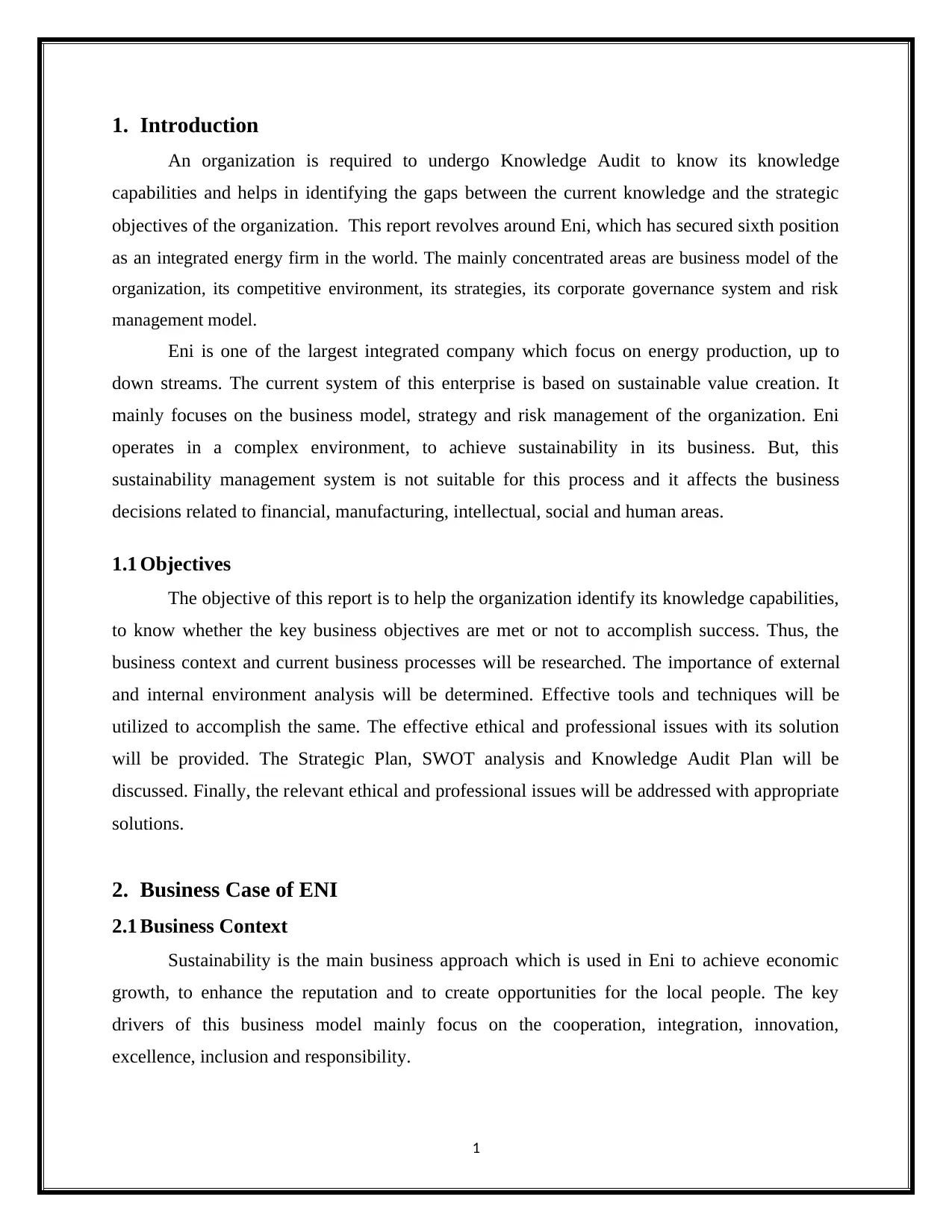
1. Introduction
An organization is required to undergo Knowledge Audit to know its knowledge
capabilities and helps in identifying the gaps between the current knowledge and the strategic
objectives of the organization. This report revolves around Eni, which has secured sixth position
as an integrated energy firm in the world. The mainly concentrated areas are business model of the
organization, its competitive environment, its strategies, its corporate governance system and risk
management model.
Eni is one of the largest integrated company which focus on energy production, up to
down streams. The current system of this enterprise is based on sustainable value creation. It
mainly focuses on the business model, strategy and risk management of the organization. Eni
operates in a complex environment, to achieve sustainability in its business. But, this
sustainability management system is not suitable for this process and it affects the business
decisions related to financial, manufacturing, intellectual, social and human areas.
1.1 Objectives
The objective of this report is to help the organization identify its knowledge capabilities,
to know whether the key business objectives are met or not to accomplish success. Thus, the
business context and current business processes will be researched. The importance of external
and internal environment analysis will be determined. Effective tools and techniques will be
utilized to accomplish the same. The effective ethical and professional issues with its solution
will be provided. The Strategic Plan, SWOT analysis and Knowledge Audit Plan will be
discussed. Finally, the relevant ethical and professional issues will be addressed with appropriate
solutions.
2. Business Case of ENI
2.1 Business Context
Sustainability is the main business approach which is used in Eni to achieve economic
growth, to enhance the reputation and to create opportunities for the local people. The key
drivers of this business model mainly focus on the cooperation, integration, innovation,
excellence, inclusion and responsibility.
1
An organization is required to undergo Knowledge Audit to know its knowledge
capabilities and helps in identifying the gaps between the current knowledge and the strategic
objectives of the organization. This report revolves around Eni, which has secured sixth position
as an integrated energy firm in the world. The mainly concentrated areas are business model of the
organization, its competitive environment, its strategies, its corporate governance system and risk
management model.
Eni is one of the largest integrated company which focus on energy production, up to
down streams. The current system of this enterprise is based on sustainable value creation. It
mainly focuses on the business model, strategy and risk management of the organization. Eni
operates in a complex environment, to achieve sustainability in its business. But, this
sustainability management system is not suitable for this process and it affects the business
decisions related to financial, manufacturing, intellectual, social and human areas.
1.1 Objectives
The objective of this report is to help the organization identify its knowledge capabilities,
to know whether the key business objectives are met or not to accomplish success. Thus, the
business context and current business processes will be researched. The importance of external
and internal environment analysis will be determined. Effective tools and techniques will be
utilized to accomplish the same. The effective ethical and professional issues with its solution
will be provided. The Strategic Plan, SWOT analysis and Knowledge Audit Plan will be
discussed. Finally, the relevant ethical and professional issues will be addressed with appropriate
solutions.
2. Business Case of ENI
2.1 Business Context
Sustainability is the main business approach which is used in Eni to achieve economic
growth, to enhance the reputation and to create opportunities for the local people. The key
drivers of this business model mainly focus on the cooperation, integration, innovation,
excellence, inclusion and responsibility.
1
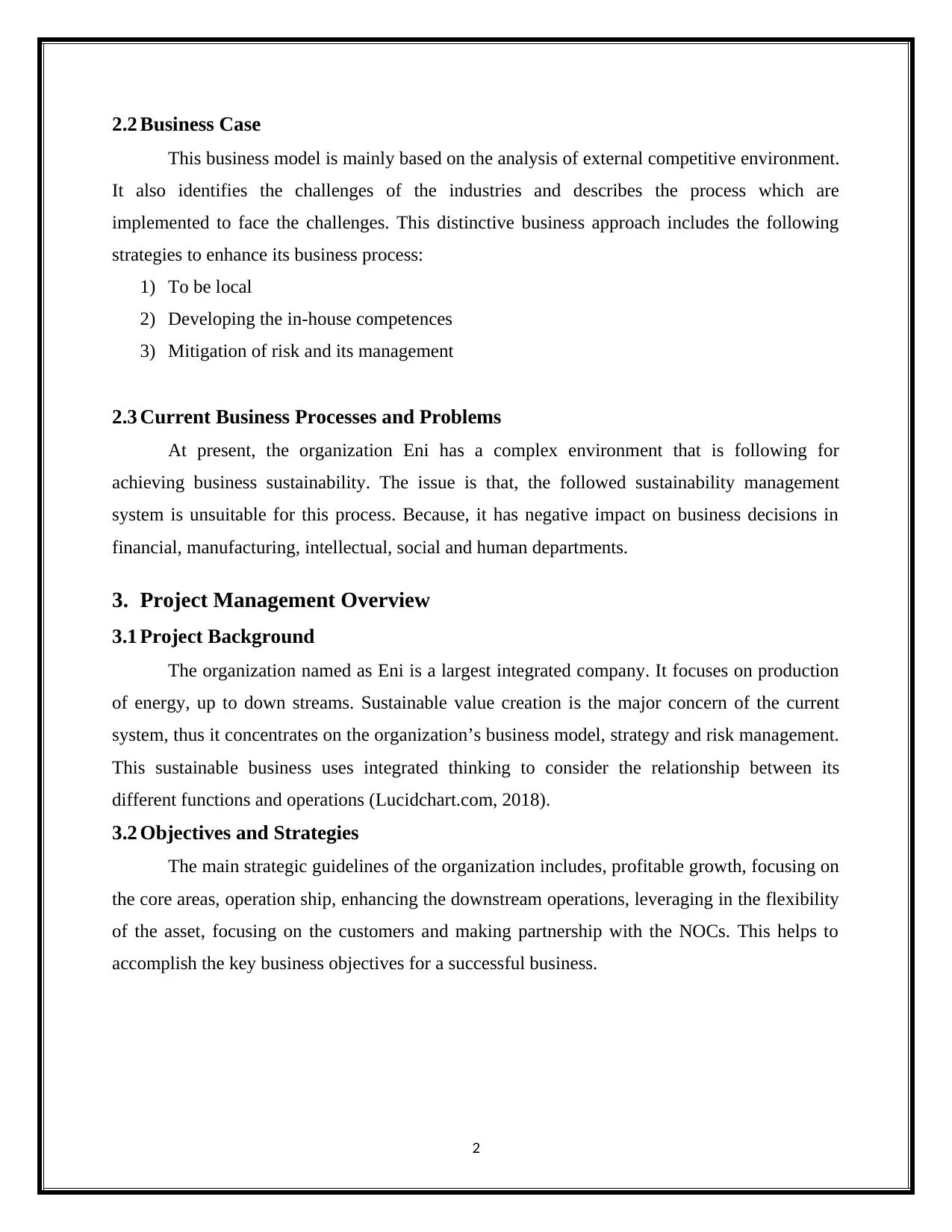
2.2 Business Case
This business model is mainly based on the analysis of external competitive environment.
It also identifies the challenges of the industries and describes the process which are
implemented to face the challenges. This distinctive business approach includes the following
strategies to enhance its business process:
1) To be local
2) Developing the in-house competences
3) Mitigation of risk and its management
2.3 Current Business Processes and Problems
At present, the organization Eni has a complex environment that is following for
achieving business sustainability. The issue is that, the followed sustainability management
system is unsuitable for this process. Because, it has negative impact on business decisions in
financial, manufacturing, intellectual, social and human departments.
3. Project Management Overview
3.1 Project Background
The organization named as Eni is a largest integrated company. It focuses on production
of energy, up to down streams. Sustainable value creation is the major concern of the current
system, thus it concentrates on the organization’s business model, strategy and risk management.
This sustainable business uses integrated thinking to consider the relationship between its
different functions and operations (Lucidchart.com, 2018).
3.2 Objectives and Strategies
The main strategic guidelines of the organization includes, profitable growth, focusing on
the core areas, operation ship, enhancing the downstream operations, leveraging in the flexibility
of the asset, focusing on the customers and making partnership with the NOCs. This helps to
accomplish the key business objectives for a successful business.
2
This business model is mainly based on the analysis of external competitive environment.
It also identifies the challenges of the industries and describes the process which are
implemented to face the challenges. This distinctive business approach includes the following
strategies to enhance its business process:
1) To be local
2) Developing the in-house competences
3) Mitigation of risk and its management
2.3 Current Business Processes and Problems
At present, the organization Eni has a complex environment that is following for
achieving business sustainability. The issue is that, the followed sustainability management
system is unsuitable for this process. Because, it has negative impact on business decisions in
financial, manufacturing, intellectual, social and human departments.
3. Project Management Overview
3.1 Project Background
The organization named as Eni is a largest integrated company. It focuses on production
of energy, up to down streams. Sustainable value creation is the major concern of the current
system, thus it concentrates on the organization’s business model, strategy and risk management.
This sustainable business uses integrated thinking to consider the relationship between its
different functions and operations (Lucidchart.com, 2018).
3.2 Objectives and Strategies
The main strategic guidelines of the organization includes, profitable growth, focusing on
the core areas, operation ship, enhancing the downstream operations, leveraging in the flexibility
of the asset, focusing on the customers and making partnership with the NOCs. This helps to
accomplish the key business objectives for a successful business.
2
⊘ This is a preview!⊘
Do you want full access?
Subscribe today to unlock all pages.

Trusted by 1+ million students worldwide
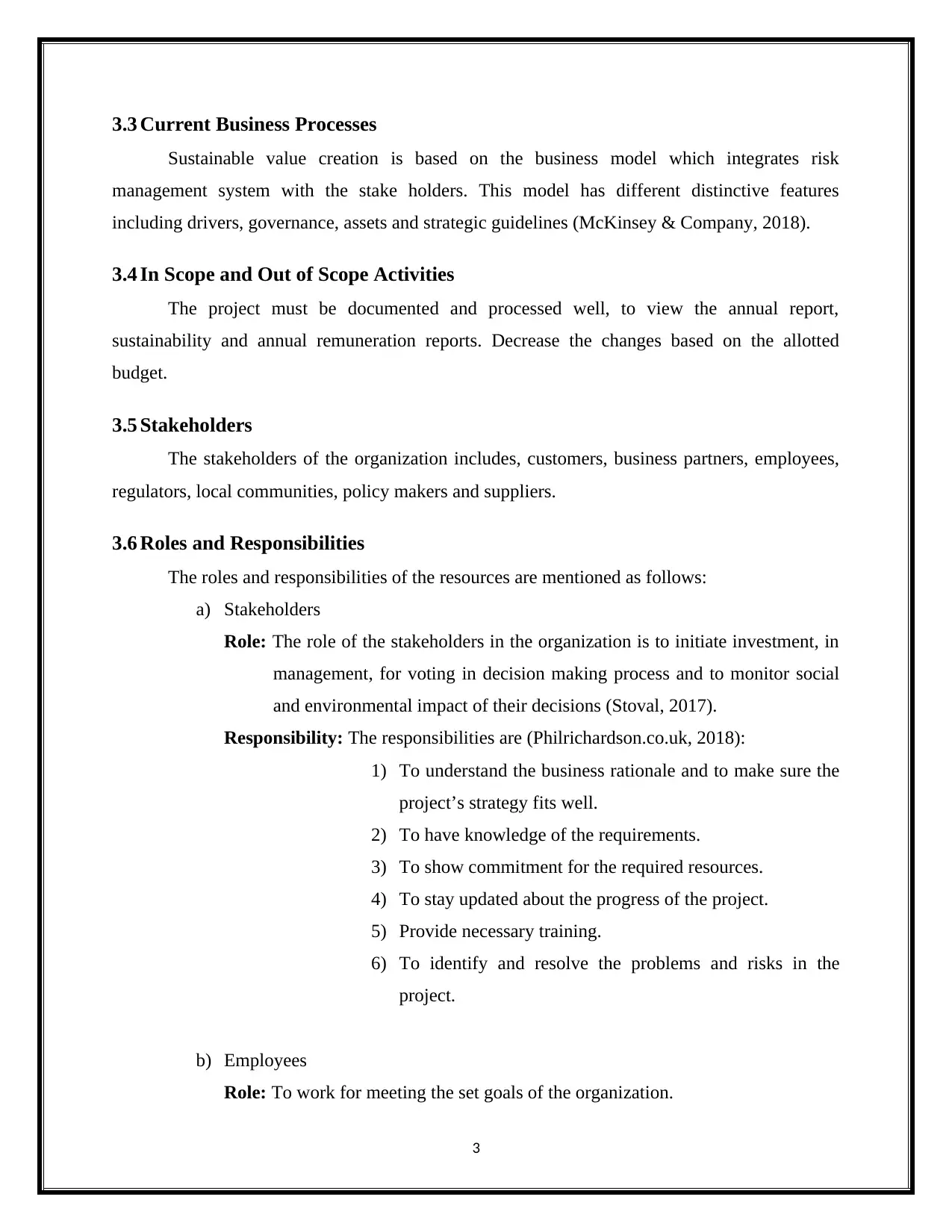
3.3 Current Business Processes
Sustainable value creation is based on the business model which integrates risk
management system with the stake holders. This model has different distinctive features
including drivers, governance, assets and strategic guidelines (McKinsey & Company, 2018).
3.4 In Scope and Out of Scope Activities
The project must be documented and processed well, to view the annual report,
sustainability and annual remuneration reports. Decrease the changes based on the allotted
budget.
3.5 Stakeholders
The stakeholders of the organization includes, customers, business partners, employees,
regulators, local communities, policy makers and suppliers.
3.6 Roles and Responsibilities
The roles and responsibilities of the resources are mentioned as follows:
a) Stakeholders
Role: The role of the stakeholders in the organization is to initiate investment, in
management, for voting in decision making process and to monitor social
and environmental impact of their decisions (Stoval, 2017).
Responsibility: The responsibilities are (Philrichardson.co.uk, 2018):
1) To understand the business rationale and to make sure the
project’s strategy fits well.
2) To have knowledge of the requirements.
3) To show commitment for the required resources.
4) To stay updated about the progress of the project.
5) Provide necessary training.
6) To identify and resolve the problems and risks in the
project.
b) Employees
Role: To work for meeting the set goals of the organization.
3
Sustainable value creation is based on the business model which integrates risk
management system with the stake holders. This model has different distinctive features
including drivers, governance, assets and strategic guidelines (McKinsey & Company, 2018).
3.4 In Scope and Out of Scope Activities
The project must be documented and processed well, to view the annual report,
sustainability and annual remuneration reports. Decrease the changes based on the allotted
budget.
3.5 Stakeholders
The stakeholders of the organization includes, customers, business partners, employees,
regulators, local communities, policy makers and suppliers.
3.6 Roles and Responsibilities
The roles and responsibilities of the resources are mentioned as follows:
a) Stakeholders
Role: The role of the stakeholders in the organization is to initiate investment, in
management, for voting in decision making process and to monitor social
and environmental impact of their decisions (Stoval, 2017).
Responsibility: The responsibilities are (Philrichardson.co.uk, 2018):
1) To understand the business rationale and to make sure the
project’s strategy fits well.
2) To have knowledge of the requirements.
3) To show commitment for the required resources.
4) To stay updated about the progress of the project.
5) Provide necessary training.
6) To identify and resolve the problems and risks in the
project.
b) Employees
Role: To work for meeting the set goals of the organization.
3
Paraphrase This Document
Need a fresh take? Get an instant paraphrase of this document with our AI Paraphraser
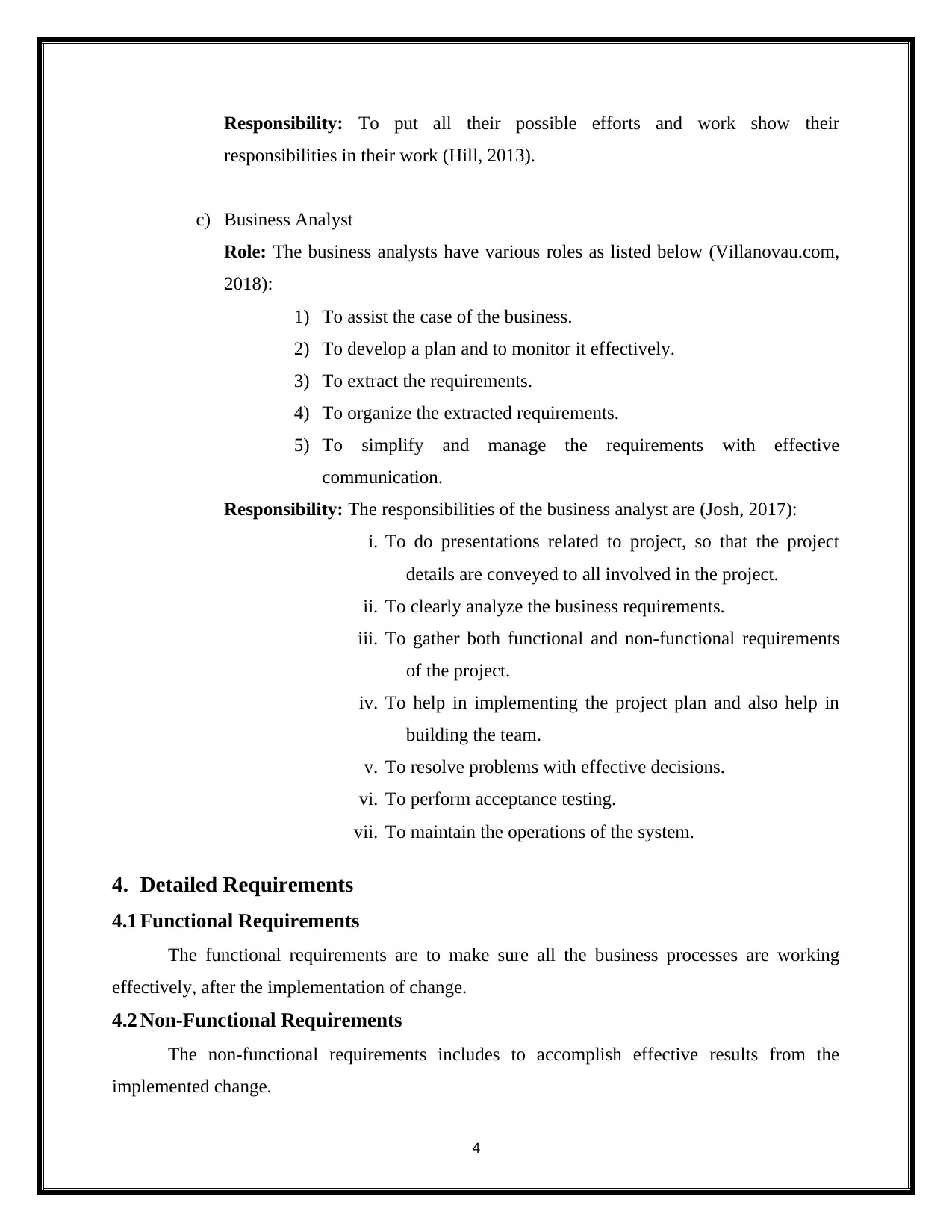
Responsibility: To put all their possible efforts and work show their
responsibilities in their work (Hill, 2013).
c) Business Analyst
Role: The business analysts have various roles as listed below (Villanovau.com,
2018):
1) To assist the case of the business.
2) To develop a plan and to monitor it effectively.
3) To extract the requirements.
4) To organize the extracted requirements.
5) To simplify and manage the requirements with effective
communication.
Responsibility: The responsibilities of the business analyst are (Josh, 2017):
i. To do presentations related to project, so that the project
details are conveyed to all involved in the project.
ii. To clearly analyze the business requirements.
iii. To gather both functional and non-functional requirements
of the project.
iv. To help in implementing the project plan and also help in
building the team.
v. To resolve problems with effective decisions.
vi. To perform acceptance testing.
vii. To maintain the operations of the system.
4. Detailed Requirements
4.1 Functional Requirements
The functional requirements are to make sure all the business processes are working
effectively, after the implementation of change.
4.2 Non-Functional Requirements
The non-functional requirements includes to accomplish effective results from the
implemented change.
4
responsibilities in their work (Hill, 2013).
c) Business Analyst
Role: The business analysts have various roles as listed below (Villanovau.com,
2018):
1) To assist the case of the business.
2) To develop a plan and to monitor it effectively.
3) To extract the requirements.
4) To organize the extracted requirements.
5) To simplify and manage the requirements with effective
communication.
Responsibility: The responsibilities of the business analyst are (Josh, 2017):
i. To do presentations related to project, so that the project
details are conveyed to all involved in the project.
ii. To clearly analyze the business requirements.
iii. To gather both functional and non-functional requirements
of the project.
iv. To help in implementing the project plan and also help in
building the team.
v. To resolve problems with effective decisions.
vi. To perform acceptance testing.
vii. To maintain the operations of the system.
4. Detailed Requirements
4.1 Functional Requirements
The functional requirements are to make sure all the business processes are working
effectively, after the implementation of change.
4.2 Non-Functional Requirements
The non-functional requirements includes to accomplish effective results from the
implemented change.
4
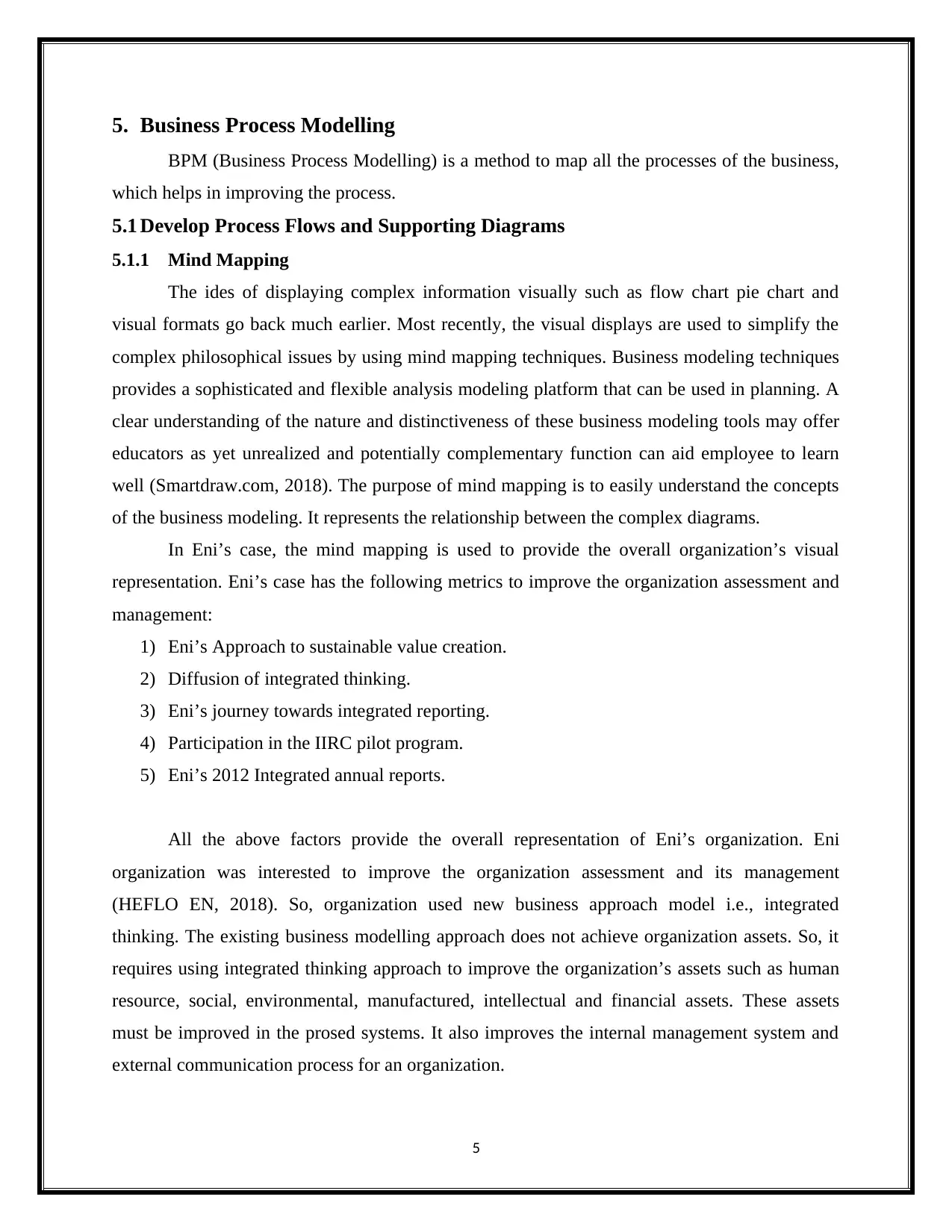
5. Business Process Modelling
BPM (Business Process Modelling) is a method to map all the processes of the business,
which helps in improving the process.
5.1 Develop Process Flows and Supporting Diagrams
5.1.1 Mind Mapping
The ides of displaying complex information visually such as flow chart pie chart and
visual formats go back much earlier. Most recently, the visual displays are used to simplify the
complex philosophical issues by using mind mapping techniques. Business modeling techniques
provides a sophisticated and flexible analysis modeling platform that can be used in planning. A
clear understanding of the nature and distinctiveness of these business modeling tools may offer
educators as yet unrealized and potentially complementary function can aid employee to learn
well (Smartdraw.com, 2018). The purpose of mind mapping is to easily understand the concepts
of the business modeling. It represents the relationship between the complex diagrams.
In Eni’s case, the mind mapping is used to provide the overall organization’s visual
representation. Eni’s case has the following metrics to improve the organization assessment and
management:
1) Eni’s Approach to sustainable value creation.
2) Diffusion of integrated thinking.
3) Eni’s journey towards integrated reporting.
4) Participation in the IIRC pilot program.
5) Eni’s 2012 Integrated annual reports.
All the above factors provide the overall representation of Eni’s organization. Eni
organization was interested to improve the organization assessment and its management
(HEFLO EN, 2018). So, organization used new business approach model i.e., integrated
thinking. The existing business modelling approach does not achieve organization assets. So, it
requires using integrated thinking approach to improve the organization’s assets such as human
resource, social, environmental, manufactured, intellectual and financial assets. These assets
must be improved in the prosed systems. It also improves the internal management system and
external communication process for an organization.
5
BPM (Business Process Modelling) is a method to map all the processes of the business,
which helps in improving the process.
5.1 Develop Process Flows and Supporting Diagrams
5.1.1 Mind Mapping
The ides of displaying complex information visually such as flow chart pie chart and
visual formats go back much earlier. Most recently, the visual displays are used to simplify the
complex philosophical issues by using mind mapping techniques. Business modeling techniques
provides a sophisticated and flexible analysis modeling platform that can be used in planning. A
clear understanding of the nature and distinctiveness of these business modeling tools may offer
educators as yet unrealized and potentially complementary function can aid employee to learn
well (Smartdraw.com, 2018). The purpose of mind mapping is to easily understand the concepts
of the business modeling. It represents the relationship between the complex diagrams.
In Eni’s case, the mind mapping is used to provide the overall organization’s visual
representation. Eni’s case has the following metrics to improve the organization assessment and
management:
1) Eni’s Approach to sustainable value creation.
2) Diffusion of integrated thinking.
3) Eni’s journey towards integrated reporting.
4) Participation in the IIRC pilot program.
5) Eni’s 2012 Integrated annual reports.
All the above factors provide the overall representation of Eni’s organization. Eni
organization was interested to improve the organization assessment and its management
(HEFLO EN, 2018). So, organization used new business approach model i.e., integrated
thinking. The existing business modelling approach does not achieve organization assets. So, it
requires using integrated thinking approach to improve the organization’s assets such as human
resource, social, environmental, manufactured, intellectual and financial assets. These assets
must be improved in the prosed systems. It also improves the internal management system and
external communication process for an organization.
5
⊘ This is a preview!⊘
Do you want full access?
Subscribe today to unlock all pages.

Trusted by 1+ million students worldwide
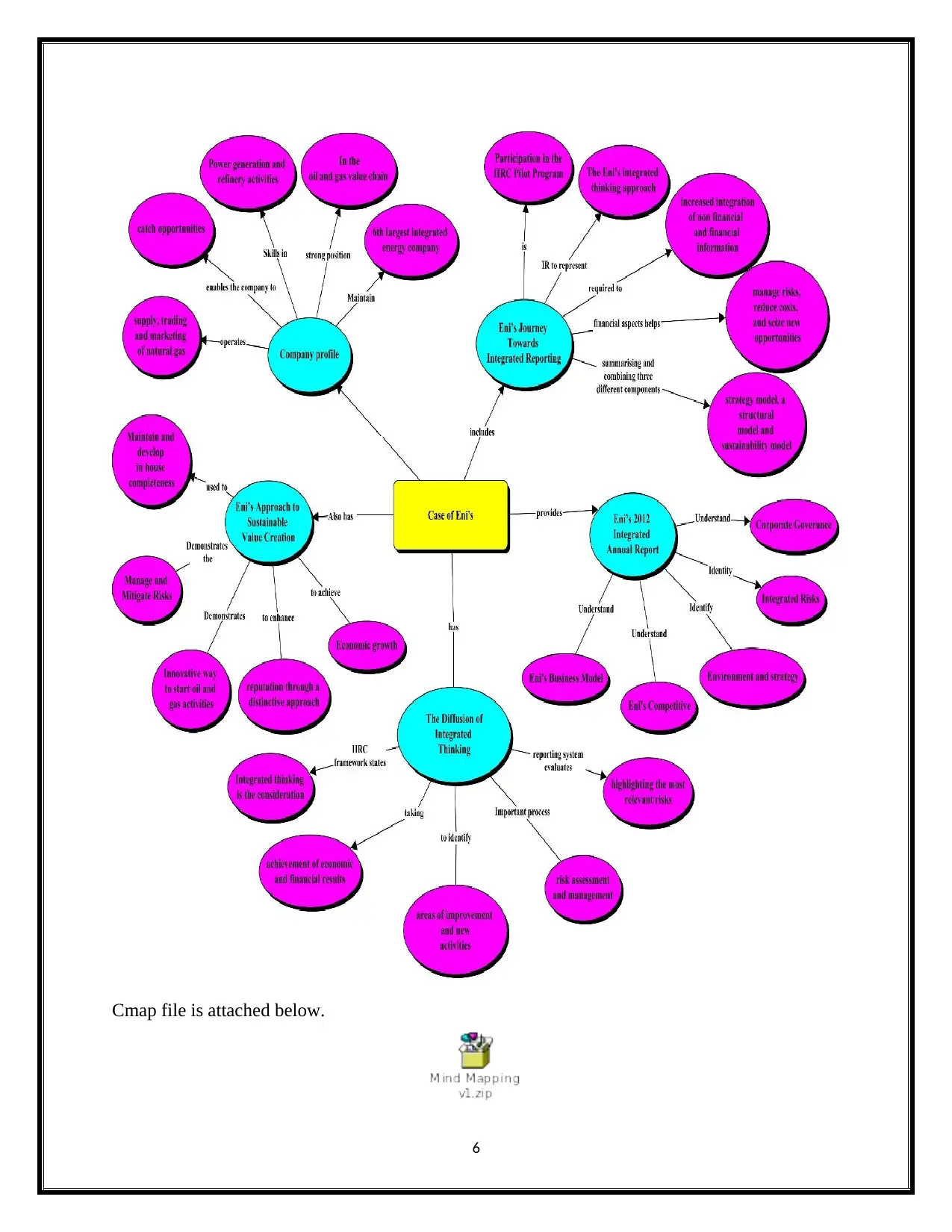
Cmap file is attached below.
6
6
Paraphrase This Document
Need a fresh take? Get an instant paraphrase of this document with our AI Paraphraser
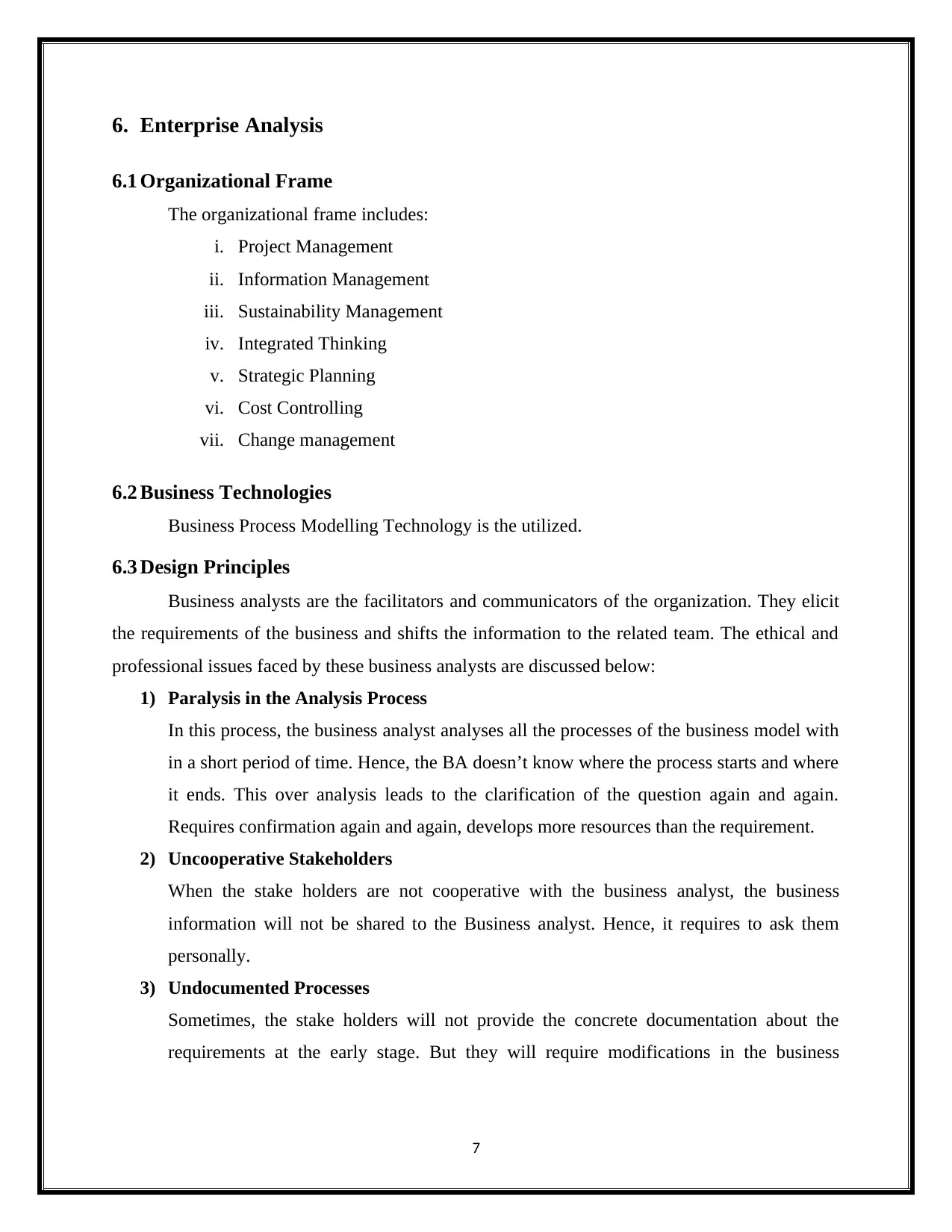
6. Enterprise Analysis
6.1 Organizational Frame
The organizational frame includes:
i. Project Management
ii. Information Management
iii. Sustainability Management
iv. Integrated Thinking
v. Strategic Planning
vi. Cost Controlling
vii. Change management
6.2 Business Technologies
Business Process Modelling Technology is the utilized.
6.3 Design Principles
Business analysts are the facilitators and communicators of the organization. They elicit
the requirements of the business and shifts the information to the related team. The ethical and
professional issues faced by these business analysts are discussed below:
1) Paralysis in the Analysis Process
In this process, the business analyst analyses all the processes of the business model with
in a short period of time. Hence, the BA doesn’t know where the process starts and where
it ends. This over analysis leads to the clarification of the question again and again.
Requires confirmation again and again, develops more resources than the requirement.
2) Uncooperative Stakeholders
When the stake holders are not cooperative with the business analyst, the business
information will not be shared to the Business analyst. Hence, it requires to ask them
personally.
3) Undocumented Processes
Sometimes, the stake holders will not provide the concrete documentation about the
requirements at the early stage. But they will require modifications in the business
7
6.1 Organizational Frame
The organizational frame includes:
i. Project Management
ii. Information Management
iii. Sustainability Management
iv. Integrated Thinking
v. Strategic Planning
vi. Cost Controlling
vii. Change management
6.2 Business Technologies
Business Process Modelling Technology is the utilized.
6.3 Design Principles
Business analysts are the facilitators and communicators of the organization. They elicit
the requirements of the business and shifts the information to the related team. The ethical and
professional issues faced by these business analysts are discussed below:
1) Paralysis in the Analysis Process
In this process, the business analyst analyses all the processes of the business model with
in a short period of time. Hence, the BA doesn’t know where the process starts and where
it ends. This over analysis leads to the clarification of the question again and again.
Requires confirmation again and again, develops more resources than the requirement.
2) Uncooperative Stakeholders
When the stake holders are not cooperative with the business analyst, the business
information will not be shared to the Business analyst. Hence, it requires to ask them
personally.
3) Undocumented Processes
Sometimes, the stake holders will not provide the concrete documentation about the
requirements at the early stage. But they will require modifications in the business
7
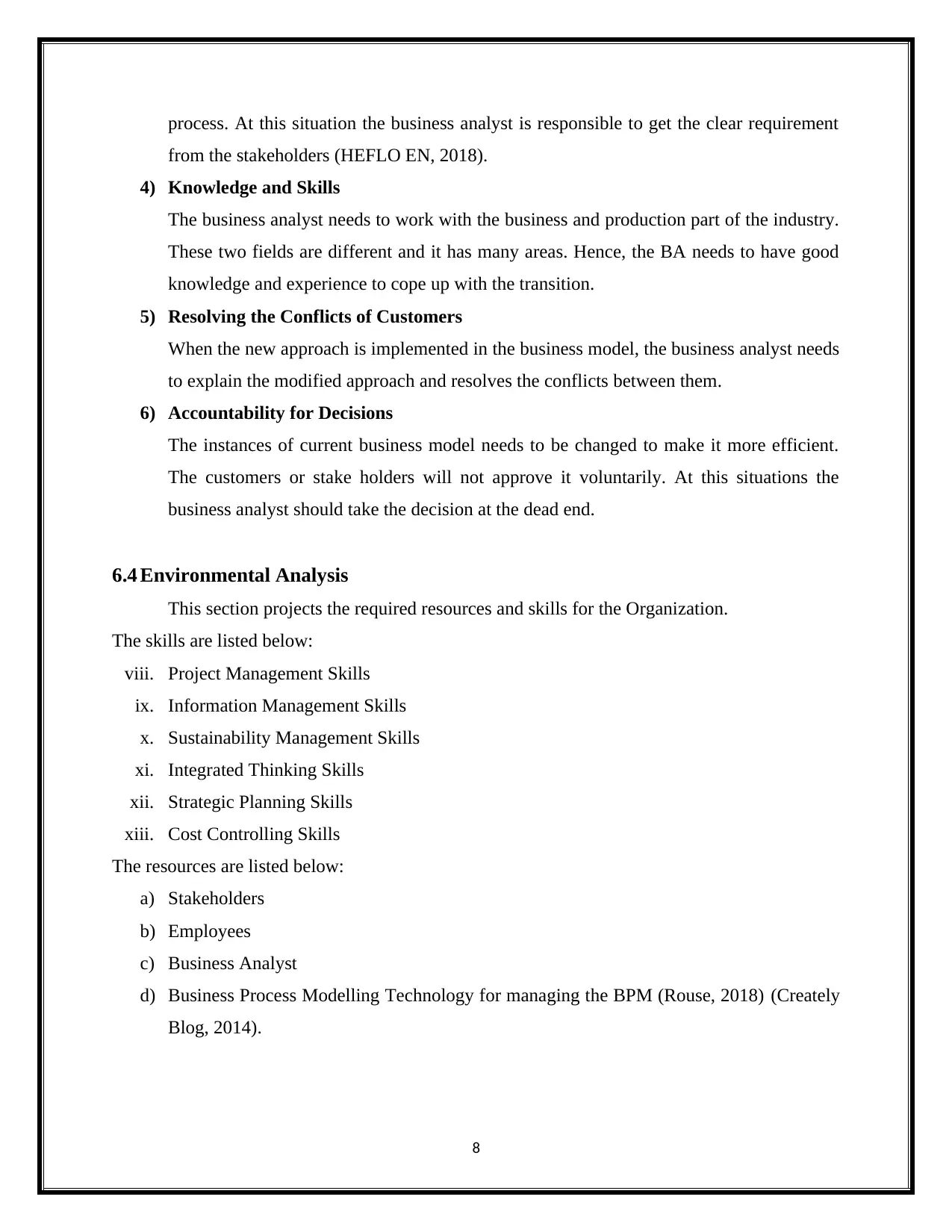
process. At this situation the business analyst is responsible to get the clear requirement
from the stakeholders (HEFLO EN, 2018).
4) Knowledge and Skills
The business analyst needs to work with the business and production part of the industry.
These two fields are different and it has many areas. Hence, the BA needs to have good
knowledge and experience to cope up with the transition.
5) Resolving the Conflicts of Customers
When the new approach is implemented in the business model, the business analyst needs
to explain the modified approach and resolves the conflicts between them.
6) Accountability for Decisions
The instances of current business model needs to be changed to make it more efficient.
The customers or stake holders will not approve it voluntarily. At this situations the
business analyst should take the decision at the dead end.
6.4 Environmental Analysis
This section projects the required resources and skills for the Organization.
The skills are listed below:
viii. Project Management Skills
ix. Information Management Skills
x. Sustainability Management Skills
xi. Integrated Thinking Skills
xii. Strategic Planning Skills
xiii. Cost Controlling Skills
The resources are listed below:
a) Stakeholders
b) Employees
c) Business Analyst
d) Business Process Modelling Technology for managing the BPM (Rouse, 2018) (Creately
Blog, 2014).
8
from the stakeholders (HEFLO EN, 2018).
4) Knowledge and Skills
The business analyst needs to work with the business and production part of the industry.
These two fields are different and it has many areas. Hence, the BA needs to have good
knowledge and experience to cope up with the transition.
5) Resolving the Conflicts of Customers
When the new approach is implemented in the business model, the business analyst needs
to explain the modified approach and resolves the conflicts between them.
6) Accountability for Decisions
The instances of current business model needs to be changed to make it more efficient.
The customers or stake holders will not approve it voluntarily. At this situations the
business analyst should take the decision at the dead end.
6.4 Environmental Analysis
This section projects the required resources and skills for the Organization.
The skills are listed below:
viii. Project Management Skills
ix. Information Management Skills
x. Sustainability Management Skills
xi. Integrated Thinking Skills
xii. Strategic Planning Skills
xiii. Cost Controlling Skills
The resources are listed below:
a) Stakeholders
b) Employees
c) Business Analyst
d) Business Process Modelling Technology for managing the BPM (Rouse, 2018) (Creately
Blog, 2014).
8
⊘ This is a preview!⊘
Do you want full access?
Subscribe today to unlock all pages.

Trusted by 1+ million students worldwide
1 out of 21
Related Documents
Your All-in-One AI-Powered Toolkit for Academic Success.
+13062052269
info@desklib.com
Available 24*7 on WhatsApp / Email
![[object Object]](/_next/static/media/star-bottom.7253800d.svg)
Unlock your academic potential
Copyright © 2020–2025 A2Z Services. All Rights Reserved. Developed and managed by ZUCOL.




